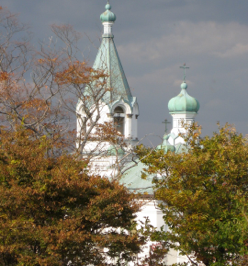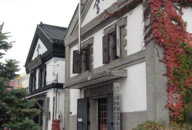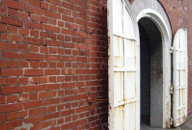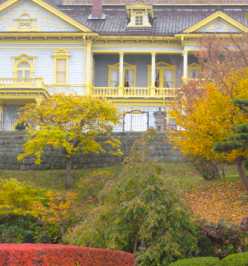HAKODATE
island of Hokkaido
Hokkaido REGION, hokkaido prefecture
Japan
november 5 - 8, 2007


HAKODATE
island of Hokkaido
Hokkaido REGION, hokkaido prefecture
Japan
november 5 - 8, 2007




Hakodate, opened in 1859 as Japan’s first international trading port along with Nagasaki and Yokohama. Since then, Hakadote has played an important role as the gateway to Hokkaido. It has been prosperous and productive as a trading and fishery base. The Preservation District, important in the development of the city, is the historic district of Hakodate. The area, covering 14.5 hectars/35 acres includes many churches, temples, diplomatic establishments, and old warehouses, all built overlooking the harbor. Scattered amongst these historic buildings are townhouses, some built in Japanese style, others in western style, and still others in a style that merges east with west in a Japanese-western style. It was interesting to see the influence of Russian architecture on the 18th and 19th century cityscape, including the onion domes of the Russian Orthodox Church. Friendly relations with Russia were established by Kahei Takadaya after the “Golovin Incident”. A Russian consulate was established in Hakone, including a chapel where Nicholas of Japan is credited with introducing the Eastern Orthodox Christianity to Japan in 1861, now the Japanese Orthodox Church. Henry and I spent a whole day on a self-guided walking tour of this fascinating port. The tour included stops at the Hakodate Russian Orthodox Church, the old British Consulate, the Old Public Hall of the Hakodate Ward, and the old Warehouses that have been transformed to include shopping malls and a beer hall. We ended our day overlooking the city from the heights of Mount Hakadote. Because the Ropeway cable car was closed for its annual maintenance, Henry and I took a taxi to the summit of Mount Hakadote, then descended the mountain by foot during twilight, stopping to see the Koyu-ji Temple, the Foreign Cemetery, and the Kannon-do memorial to Kahei Takadaya.
PHOTOS: Upper Left: 1. The Hanamori Warehouses, built in 1907, were constructed of Timber-Framed brick with walls two and one-half bricks thick, symbolic of its history. These warehouses are often used for as “location” for the films. 2. A Japanese maple frames the roofline of a building in Hakadote’s Preservation District. 3. An old pine tree and landscaping around the moat of the fortress in Goryokaku Park.Center: The onion domes of the Russian Orthodox Church. Center, Bottom: The Old Public Hall of the Hakodate Ward. Right Column: 1.Buildings from the days of Kahei Takadaya, when commercialism opened in the port of Hakadote, c. 1779. 2. View of a cobblestone street in the Preservation District of Hakadote, its foliage in full Autumn color. 3. View of the grounds of Goryokaku Park with moat and bridge.


Preservation District




